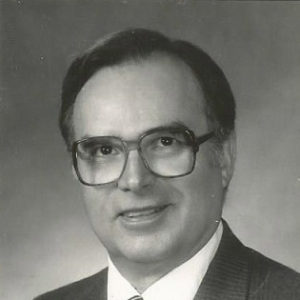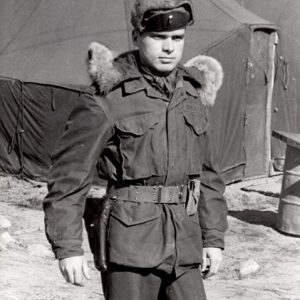calsfoundation@cals.org
Eugene Wilson Smith (1930–2018)
Eugene W. Smith became a professor and administrator at Arkansas State University (ASU) in Jonesboro (Craighead County), and his work was instrumental in gaining the institution university status. He was appointed president of ASU in 1984 and oversaw major expansions of the university’s physical plant, double-digit growth in enrollment, and the establishment of ASU’s first doctoral program.
A native of Forrest City (St. Francis County), Eugene Wilson Smith was born on June 10, 1930, to Milton Samuel Smith II and Frank Leslie Wilson Smith; he had two siblings. His father and mother were longtime educators, serving as school superintendent and classroom teacher, respectively, in the Forrest City school system. Smith enjoyed fishing and quail hunting with his father and developed a deep enjoyment of reading. In high school, he was manager for the football team.
In 1952, Smith earned a BA in English at what was then Arkansas State College; he also was commissioned as an army second lieutenant through the Reserve Officers’ Training Corps (ROTC), which had designated him as a distinguished military graduate. Trained as a forward observer and sharpshooter, he served during the Korean War as an artillery officer and was promoted to first lieutenant. After being honorably discharged in 1954, he resumed his formal education, completing a Master of Education degree in 1955 and a Doctor of Education degree in 1958, both at the University of Mississippi.
He began his career at Arkansas State in 1958, serving the university in various capacities over the next thirty-four years. He was an instructor, associate professor, and professor of education before serving as President Carl R. Reng’s executive assistant, during which time he was instrumental in the institution’s successful quest for university status during the 1967 session of the Arkansas General Assembly. Among his contributions, he assisted in compiling institutional data that helped justify the status change and helped garner support through networks of alumni and institutional boosters. The legislation, signed into law by Governor Winthrop Rockefeller, took effect on July 1 of that year.
Over the next seventeen years, Smith served in various roles, including vice president for administration, dean of the Graduate School, senior vice president, and interim president. After the University of Arkansas Board of Trustees hired ASU’s president, Ray Thornton, to become head of the University of Arkansas in Fayetteville (Washington County), ASU’s Board of Trustees almost immediately appointed Smith as ASU’s eighth president during a special meeting in January 1984, with the appointment becoming effective on February 15.
Over the next eight years, Smith led the school through one of its greatest eras of growth and development. Smith took particular pride in several highlights of his presidency, including establishment of the institution’s first doctoral degree program, in educational leadership; construction of the Convocation Center (now First National Bank Arena); a major expansion of the Dean B. Ellis Library, including a bell tower; change of the university’s Department of Athletics to Division I (now Football Bowl Subdivision) status in the National Collegiate Athletic Association (NCAA); and early steps toward formation of the Arkansas State University System. Enrollment grew from 8,319 in the fall semester of 1984 to 10,416 in the fall semester of 1991.
Believing he had accomplished, or at least had set in motion, his major goals, Smith announced to the faculty in August 1991 he would retire at the end of that school year. The board of trustees named him president emeritus on June 30, 1992. A little more than two years later, the board called him back to fill a vacancy and serve a second time as interim president from 1994 to 1995. During that year, he helped the board identify and recruit the institution’s next president, and he oversaw the final stages of the Ellis Library expansion and dedication. President Bill Clinton accepted Smith’s invitation to give the dedication address on April 3, 1995, and became the first sitting U.S. president to visit Arkansas State University.
His involvement in local civic affairs included serving as director, vice president, and president of the Jonesboro Regional Chamber of Commerce; alderman on the Jonesboro City Council and chair of the council’s Finance Committee; a member of the Committee for Arkansas’ Future; and president of the Jonesboro Industrial Development Corp.
He was named Arkansas Volunteer Industrial Developer of the Year in 1983. Professional memberships included the honor societies of Phi Kappa Phi, Kappa Delta Pi, Phi Delta Kappa, and Rotary International. Later in his career, the College of Education at the University of Mississippi recognized him as its Distinguished Alumnus. In 1992, the Arkansas State University Alumni Association also recognized him as a Distinguished Alumnus and made a gift establishing the Dr. Eugene W. Smith Fellowship Endowment to provide a fellowship for an outstanding doctoral program candidate each year.
In May 2009, the board of trustees renamed a campus building, which now houses programs in education and health professions, the Eugene W. Smith Hall.
Smith died on September 23, 2018.
For additional information:
Ball, Larry D., and William M. Clements. Voices from State: An Oral History of Arkansas State University. Jonesboro: Arkansas State University, 1984.
Dew, Lee A. The ASU Story: A History of Arkansas State University, 1909–1967. Jonesboro: Arkansas State University Press, 1968.
Embrace the Past 1909–2009: Celebrating Our First Century. Jonesboro: Arkansas State University, 2012.
Newsom, Glenda. “Biography of Dr. Eugene W. Smith: Arkansas State University President, 1984 to 1992.” EdD diss., Arkansas State University, 2012.
Thomas Moore
Arkansas State University
 Divergent Prosperity and the Arc of Reform, 1968–2022
Divergent Prosperity and the Arc of Reform, 1968–2022 Education, Higher
Education, Higher Eugene Smith
Eugene Smith  Eugene Smith
Eugene Smith 




Comments
No comments on this entry yet.